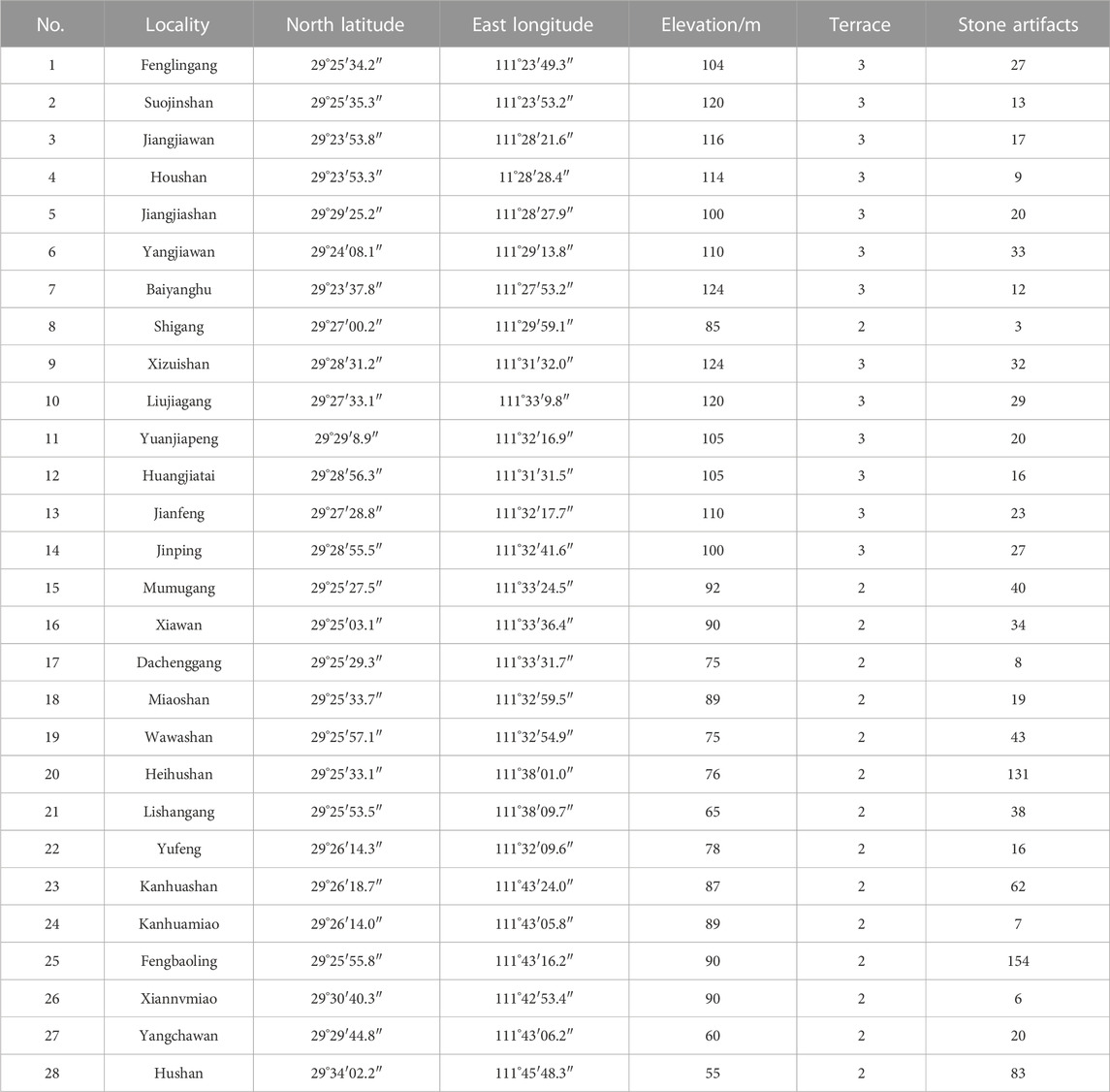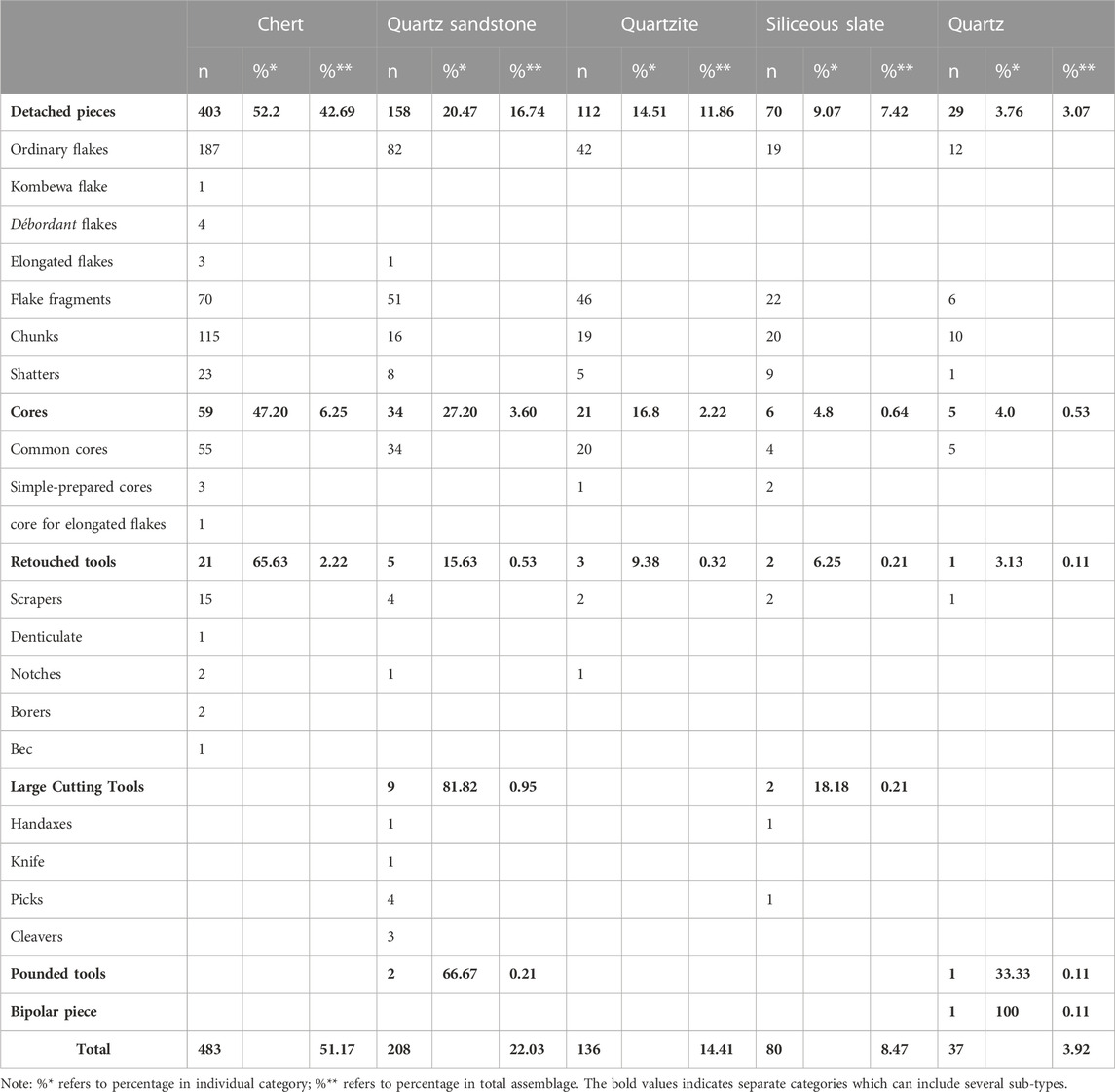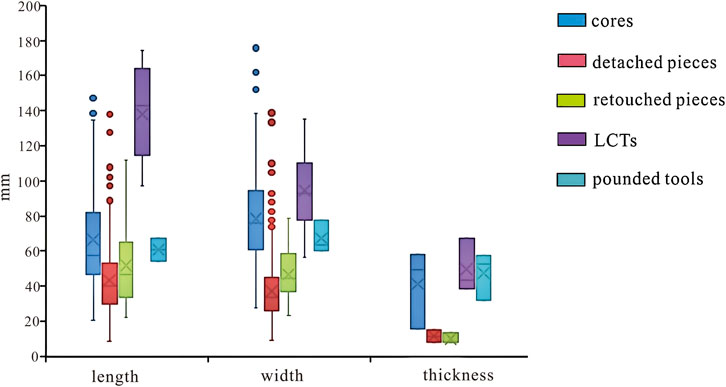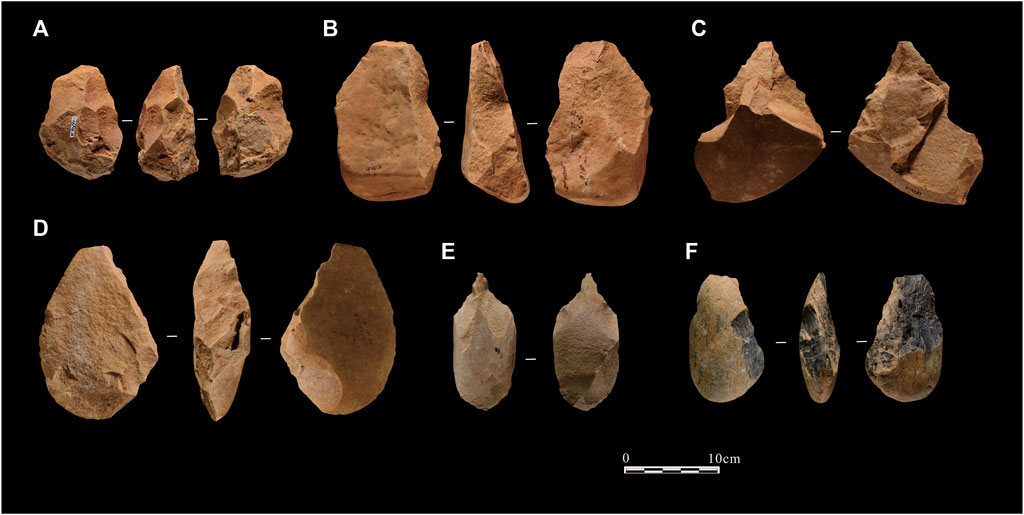- 1Hunan Provincial Institute of Cultural Relics and Archaeology, Changsha, China
- 2State Key Laboratory of Tibetan Plateau Earth System, Resources and Environment (TPESER), Institute of Tibetan Plateau Research, Chinese Academy of Sciences, Beijing, China
- 3Department of Anthropology, DePaul University, Chicago, IL, United States
- 4Colleage of Urban and Environmental Science, Peking University, Beijing, China
The Late Pleistocene is a crucial period of dramatic changes in lithic technologies as well as interactions between modern humans and other archaic human groups. In this paper, we describe the technological analysis of lithic assemblages collected from 28 newly discovered Paleolithic sites along the Daoshui River, a tributary of the Lishui River (itself a tributary of Yangtze River) in northern Hunan Province, central South China. Luminescence dating of several sites in this region has provided a general Late Pleistocene age range for lithic assemblages. Technologically, high quality raw materials are predominantly exploited (e.g., chert and siliceous slate) and direct hard hammer percussion predominates which lacks the classic Levallois technology though conceptually, some specimens do exhibit a certain degree of volumetric control and share other common features with prepared cores, here we tentatively define them as “simply prepared cores.” Small flakes and flake tool production plays a primary role in the overall technological strategy, accompanying a small proportion of large flakes and Large Cutting Tools production. Our examination of lithic technologies in the region clearly contrasts with the traditional view of South China being characterized by a simple cobble tool industry over the course of the Pleistocene period. We further discuss the issue of the Middle Paleolithic in China, as well as the ecological adaptations of hominins in the Daoshui River valley within a Late Pleistocene climatic context.
1 Introduction
The early Late Pleistocene is a crucial time period for the evolution and dispersal of Homo sapiens. As a vast geographic region, China has emerged as an important place for such studies, with increasing fossil, genetic and archaeological evidence. Specifically in South China, modern human fossils as early as ca. 100 ka have been found in the Fuyan cave, Huanglong cave, and Zhiren cave (Liu et al., 2010a; Liu et al., 2010b; Liu et al., 2015; Liu et al., 2016; Li et al., 2013). According to these new findings, a modified version of an earlier dispersal model of early modern humans along the southern part of Eurasia has been proposed (Bae et al., 2017). However, no associated cultural remains have been found at these paleo-anthropological sites, which hinders our understanding of the cultural expressions and adaptations of early modern humans in different areas.
Since the late 1980s, more than 200 Paleolithic sites and thousands of stone artifacts have been discovered in Hunan Province, central South China, and a large number of them distributed in the Daoshui River valley, a secondary tributary of the Yangtze River (Yuan, 2013). Importantly, excavated sites in this region have helped to establish the evolutionary trajectory of lithic technologies covering almost the whole time period of the Late Pleistocene. For instance, the systematic study of the Sandinggai site has pointed out that the small débitage reduction sequence became the main technological strategy since at least the early Late Pleistocene (ca. 96.6 ± 5.1 ka), though a small proportion of Large Cutting Tools (LCTs) component that inherited from the regional Middle Pleistocene technological tradition still existed (Li, 2020; Li et al., 2022). As another representative site, the site of Wuyashan has also been occupied through most of the Late Pleistocene period, from approximately 107.8 ± 10.3 ka to 34.8 ± 3.9 ka, and the lithic assemblage from the site was dominated by the small débitage flaking system, with the use of siliceous slate raw material (Li, 2019a). In general, a cultural shift or transition from the Middle Pleistocene LCTs industry to the small flakes and flake tools industry in the Late Pleistocene has been observed and discussed by scholars (Li, 2020; Li et al., 2022). It is clear that the large number of Late Pleistocene sites and abundant cultural materials discovered in the Daoshui River valley will further promote our understanding of the technological and behavioral evolution of hominins during this key time period in South China.
In this paper, we report on new open-air Paleolithic sites with rich stone artifacts recently discovered at the Daoshui River valley in central South China during the Late Pleistocene. To be specific, an intense survey of approximately 50 km along the river (Figure 1) was undertaken during which all exposed pieces were collected. We conducted detailed typological and technological analyses of the lithic assemblages, through which we were able to reconstruct the technological development and a range of human adaptive behaviors in the Late Pleistocene central South China.
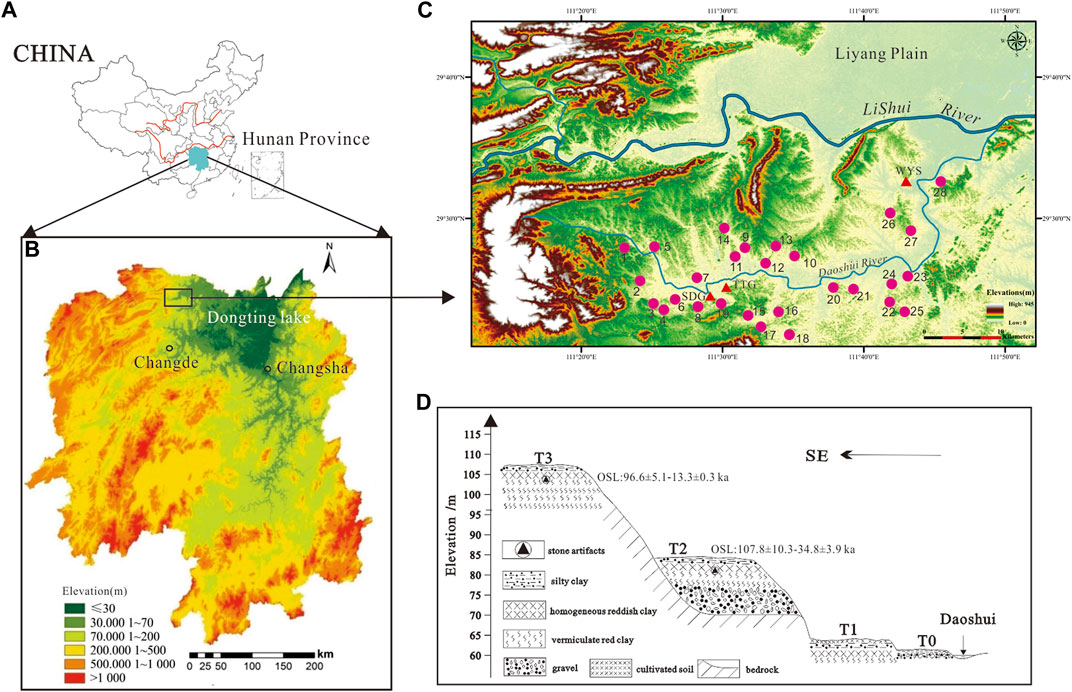
FIGURE 1. Geographic location and the Palaeolithic sites found in the Daoshui River valley. (A,B) Shows the location of the study area; (C) identifies each paleolithic site with a solid pink circle (the numbers represent different sites in Table 1), including those mentioned in the text- Wuyashan/WYS, Sandinggai/SDG and Tiaotougang/TTG identified by a solid red triangle; (D) shows the terraces in the Daoshui River and the ages of the cultural layer each terrace.
2 Sites setting
The Daoshui River valley, covering an area of ∼200 km2, is located in Changde City, approximately 180 km northwest of the Changsha City, the capital of Hunan Province in central South China (Figures 1A, B). The Daoshui River is the largest tributary of Lishui River, which is one of the southern branches of Yangtze River. Three Pleistocene terraces have been identified along the valley. These three terraces, numbered 1, 2, 3 from bottom to top (Figure 1D), are situated 65, 85, and 105 m above sea level, respectively, while the elevation of washland of Daoshui river is around 60 m. Stone artifacts of the newly identified Paleolithic sites were buried in the red clay deposits on the river terraces. With respect of the provenance of red clays in this valley, evidence from the stratigraphic features, the grain-size patterns and end-member modelling all point to an aeolian mechanism that the sediments were either transported from northern China or from the nearby desiccated fluvial deposits of the Yangtze River (Li et al., 2021; Lai et al., 2021), rather than aqueous deposits argued by some researchers (Zhu, 1988; Zhu, 1993). This evidence also imply that the ancient humans occupied the highlands surrounding the river valley during this period.
Since 2011, the Hunan Provincial Institute of Cultural Relics and Archaeology has carried out a systematic survey of the Daoshui River valley. So far, 31 Paleolithic sites have been discovered, and among them, three sites, i.e., Wuyashan, Tiaotougang, and Sandinggai, have been excavated and published (Li, 2019a; Li, 2019b; Li et al., 2022). Here we focus on the 28 unexcavated sites that have yet to be reported. All the sites are located on the third terrace (n = 13) and the second terrace (n = 15). Stone artifacts were either surface-collected or collected from the original profiles consisting of homogeneous reddish brown silty clay and underlying vermiculate red clay (Figure 1D). To date, the systametic Optically Stimulated Luminescence (OSL) dating have been applied to two excavated sites in the region, namely, the Sandinggai site and the Wuyashan site. In particular, the Sandinggai site which is located on terrace three has been dated to 96.6 ± 5.1–13.3 ± 0.3 ka (Li et al., 2022), while the Wuyashan site located on the lower terrace two has been date to 107.8 ± 10.3–34.8 ± 3.9 ka (Li, 2019a). Consequently, the occupation of these newly discovered sites can overall be assigned to the Late Pleistocene period, although these sites were located on the different terraces. A total of 944 stone artifacts have been found from these sites. The number of stone artifacts varying from more than 150 specimens to less than 10 specimens per site. Detailed information of the Paleolithic sites has been provided in Table 1. Considering the similar age ranges of sites on the different terraces, we therefore put all stone artifacts together for the technological analyses.
3 Lithic technology
3.1 Assemblage composition and raw material exploitation
As the classification system in this study shown in Table 2, detached pieces dominate the full assemblage (n = 772, 81.78%), the cores occupy a secondary role (n = 125, 13.24%), and all remaining types, including pounded tools, retouched pieces and LCTs, are underrepresented in the assemblage, with proportions of 0.32%, 3.39% and 1.17% respectively.
Flakes were produced via freehand percussion. Only one bipolar piece was identified, indicating this basic lithic knapping strategy was scarcely adopted by early hominins, but the bipolar knapping technique is possibly underestimated in a certain degree because of the rare experimental research on the unique mechanism in this region. To be specific, complete flakes in the category are dominated by ordinary flakes (n = 341), along with a small number of débordants (n = 4), Kombewa flake (n = 1) and elongated flakes (n = 4).
The size for stone artifacts is mainly small-medium in individual category (Figure 2), with an average length, width, and thickness of 47.87 × 43.64 × 22.77 mm and an average weight of 103.95 g. Both large sized cores (n = 17,13.18%) and large flakes (n = 8) demonstrate the ability and needs for producing large or heavy products. The Large Cutting Tools (n = 11) in the assemblage also support this recognition and indicate the potential link with the earlier techno-complex in the region.
There six types of raw materials were exploited by ancient humans, among them, chert (51.17%) is overabundant, followed by quartz sandstone (18.33%), and quartzite (14.51%), while siliceous slate (8.47%), sandstone (3.71%) and quartz (3.81%) only occupy a small proportion. Generally, the raw materials of cryptocrystalline and microcrystalline were dominated, indicating a selective preference of high quality raw materials (i.e., chert and siliceous slate) with predictable flaking properties. Based on cortex retained on the surface of stone artifacts, it is clear that river cobbles were the source of raw materials used at the sites. Preliminary field investigation shows that cherts and siliceous slates can be found in both the ancient gravel layers and the modern banks of the Daoshui River, but they take less proportion in the composition of gravel rock, comparing to the common components of quartz sandstone and quartzite. Although hominins still adopted a local procurement strategy for raw materials during this period, a close examination of the diachronic change from middle Pleistocene shows that the high quality raw materials dramatically increased in this region since early late Pleistocene.
In addition, considering the proportions of raw materials in different types of artifacts, 71.88% of small to medium sized retouched tools were made on chert, whereas LCTs and pounded tools were exclusively made on quartz sandstone. Therefore, this is a clear selective preference corresponding to different chaînes opératoires of tool production.
3.2 Core reduction
All the cores were free hand percussed, and various blanks have been used for the cores, including cobbles, flakes, chunks and indeterminate types. Cobbles were most frequently used, accounting for 69.77% (n = 90) of the category, followed by chunks (n = 25, 19.38%) and flake blanks (n = 8, 6.2%).
Cortex has been preserved on most of cores (n = 126, 97.67%), and cortex intervals of 30%–50% (n = 57, 44.19%) and 60%–70% (n = 38, 29.46%) are dominated. Flaking surfaces on cores are varied from one to five, with one (n = 53) and two (n = 48) flaking surfaces dominated. Cores retaining three to six scars occupy 37.98% (n = 49), and 27.13% of cores (n = 35) have scar numbers greater than ten, indicating the relatively high raw material utilization. Overall, cortex proportion and scar numbers support a moderate to slightly higher extent of core reduction. Cores with one (36.43%) or two (41.86%) platforms are most common, and the remaining cores have at least three platforms, reflecting a multi-facial flaking model. In terms of the type of platform, the combination of cortical-plain (n = 35, 27.13%) platforms is slightly higher, followed by the single cortical platform (n = 32, 24.81%) and plain-plain (n = 13, 10.08%) platform types. No deliberately prepared platform was identified from the sample currently.
According to the techno-typological classification proposed by de la Torre and his colleagues (de la Torre et al., 2003; de la Torre, 2011; de la Torre and Mora, 2018; see Figure 3A for sketching flaking models), a total of 14 flaking patterns were identified. The proportion of individual core type are present in Figure 3B. Unifacial unidirectional flaking (n = 44, 35.2%) and multi-facial (including Polyhedral) flaking (n = 27, 21.6%) are predominant, indicating the opportunistic core reduction strategy. Cores-on-flakes (n = 5, 4%), centripetal flaking (n = 7, 5.6%) and bifacial flaking (n = 18,14.4%) are relatively less present.
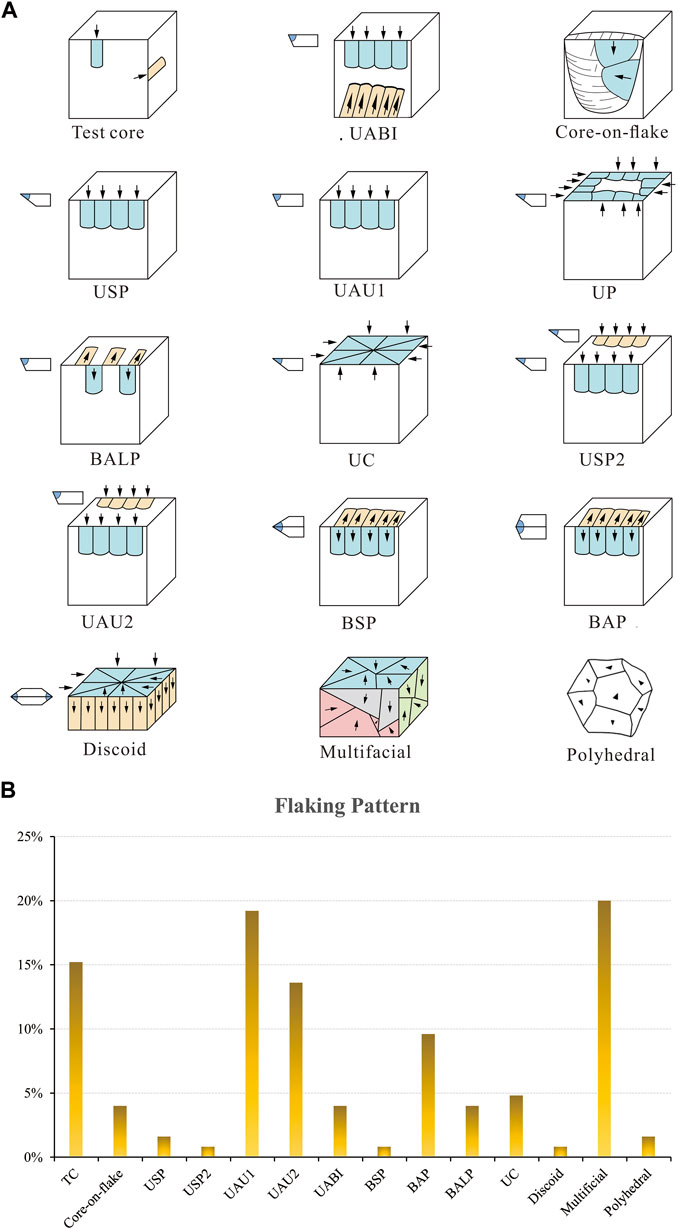
FIGURE 3. A sketch for each flaking pattern (A). Abbreviations in the sketch: TC, Tested Cores; USP, Unifacial Simple Partial exploitation; USP2, Unifacial Simple Partial exploitation2; UAU1, Unidirectional abrupt unifacial exploitation on one knapping surface; UAU2, Unidirectional abrupt unifacial exploitation on two independent knapping surfaces; UABI, Unifacial abrupt bidirectional exploitation; BSP, Bifacial simple partial exploitation; BAP, Bifacial Abrupt Partial exploitation; BALP, Bifacial Alternating Partial exploitation; UC, Unifacial Centripetal flaking. (B) Proportions of cores based on flaking patterns.
Although small in number, centripetal flaked cores are worth noting (Figure 4). All these cores show asymmetric surfaces, the flat upper surfaces were used as flaking surfaces, whereas the protruding lower surfaces functioned as the striking platforms which are often cortical or with a small number of scars. Half of the unifacial centripetal cores were seemingly prepared distally to allow for the removal of a triangular preferential flake (Figure 4E). Due to the small number of such cores, we suggest that it is currently immature to judge the real nature of them, however, this type of pattern in “rudimentary” core preparation has been noted elsewhere (see Wilkins et al., 2010; Sumner, 2013; Mesfin and Texier, 2022). Here, we tentatively define them as simply prepared cores, considering some of the technological and morphological similarities with classic Levallois cores.
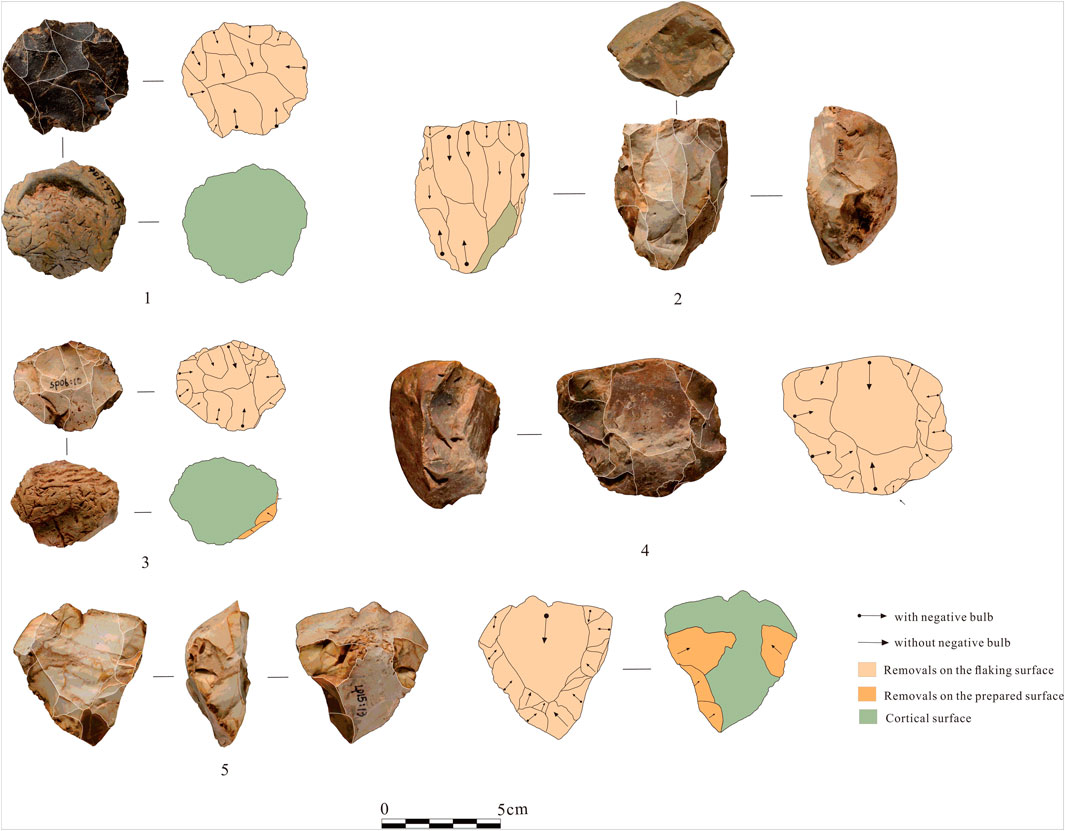
FIGURE 4. Cores discovered from Palaeolithic localities in Daoshui river valley. (A, C–E), Unifacial centripetal flaking cores; (B), Unifacial abrupt bidirectional exploitation core.
In addition, one UABI core (Figure 4B) is also worth mentioning. It was bidirectionally flaked on one surface, along with a wide oblique plain platform and a generally conical shape. Several large and elongated flakes were detached. Such characteristics conform to the broadly defined blade core reduction pattern (Shea, 2020) and probably reclaims the connection with the elongated flakes in the studied assemblages.
For the detached pieces, complete flakes (n = 350, 45.57%) and flake fragments (n = 195, 25.39%) represent the majority, followed by chunks (n = 177, 23.05%) and shatter (n = 46, 5.99%). The size of complete flakes is relatively small, with the mean maximum length and width of 44.07 mm and 40.76 mm, respectively. Although in a small number, large flakes (n = 9) which were possibly used as LCT blanks, exist in the assemblage and most of them were made on quartz sandstone. Cortical (56%) and plain (38%) platforms are well represented, followed by dihedral (2.57%), linear (2.57%) and ridged (0.57%) types. Facetted platforms occupying only 0.29%. The termination of flakes is dominated by the desirable feathered type (84.29%), indicating the good quality of raw materials and high flaking success.
Technologically, débordant flakes (n = 4), elongated flakes (n = 3) and the one Kombewa flake are also present, despite the small number (Figures 5A–D). Débordant flakes are produced to adjust striking platforms or surfaces in order to install and maintain appropriate lateral and distal core convexity (Vaquero et al., 2012; Scerri et al., 2016). The flakes of this sort examined here were made on chert and characterized by a triangular cross-section consisting of part the core edge. The Kombewa flake is characterized by having two ventral surfaces, coinciding with the existence of a particular type of core (i.e., cores-on-flake) mentioned above. Elongated flakes are parallel- or sub-parallel-sided flakes, with the length at least two times of its width, and they were produced by managing the natural ridge convexities, no platform preparation existed.
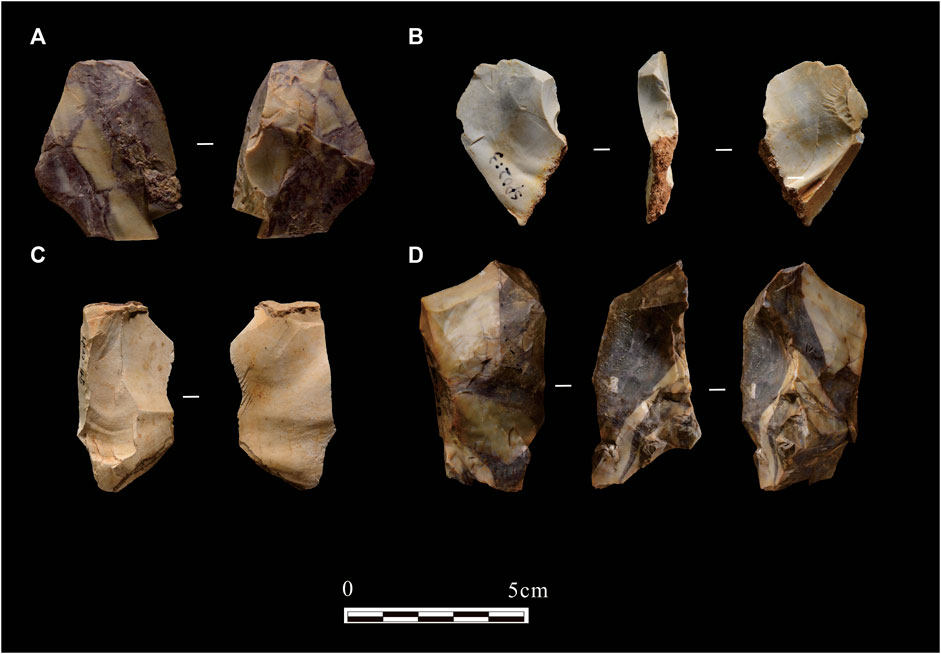
FIGURE 5. Flakes uncovered from Palaeolithic localities. (A, B, D), Débordant flakes; (C), Elongated flake.
3.3 Retouched tools
Retouched tools consist of 3.39% (n=32) in the whole assemblage (Figures 6A–I). The types of retouched tools include scrapers (n = 24), notches (n = 4), borers (n = 2), one denticulate and one bec. Chert (n = 23) was predominantly used to produce retouched tools, other raw materials such as quartz sandstone (n = 5), quartzite (n = 3) and siliceous slate (n = 1), play only a marginal role. Except for one specimen that is larger than 10 cm, others are small and medium (<10 cm), with a mean length of 51.84 mm, mean width of 46.74 mm, mean thickness of 18.74 mm, and mean weight of 60.05 g.
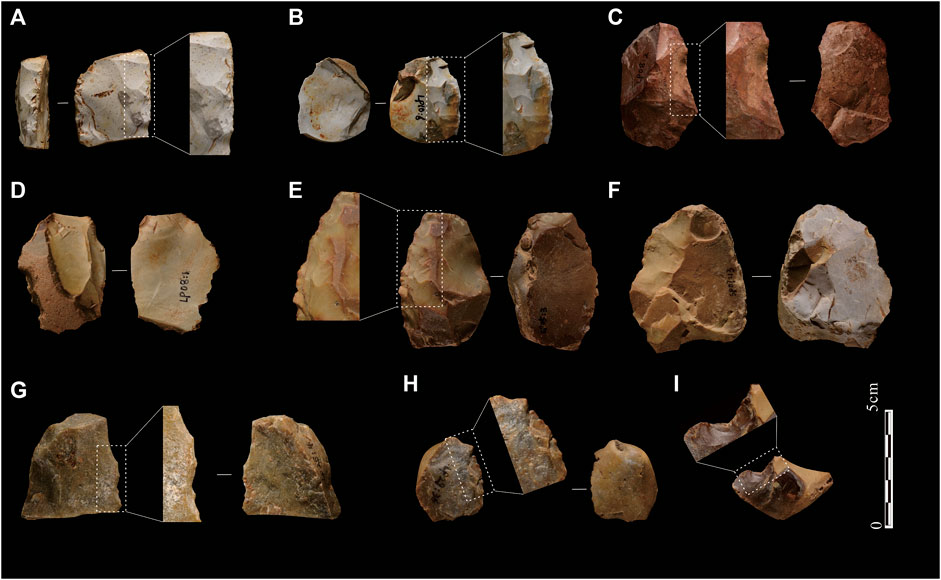
FIGURE 6. Retouched tools from survey area. (A–C) and (E–H), scrapers; (D), denticulate; (I), notch.
Flakes were mainly used as blanks (n = 25, 78.13%), followed by chunks (n = 7, 21.87%). Both inverse (n = 12) and direct retouching (from ventral to dorsal face, n = 9) were present. One sequence or row of retouching scars (n = 28, 87.5%) was the dominant pattern, with only a small number of retouched tools displaying overlapped scars (n = 4, 12.5%); overall this indicates the limited alteration of the original shape and volume of blanks, as well as the low degree of standardization on the form of retouched tools. Nevertheless, it is worth noting that some retouching scars are relatively shallow, demonstrating the existence of refined retouching on some tools (see Figures 6A, B for examples).
3.4 Large cutting tools
Large Cutting Tools (LCTs) comprise a unique component in the toolkits. Specifically, two handaxes, five picks, three cleavers and one knife have been identified (Figure 7). In addition to two LCTs made on siliceous rocks, all others were made on the coarse-grained quartz sandstone. Size and weight of LCTs are significantly larger and heavier than retouched tools, with a mean length of 138.04 mm, mean width of 94.43 mm, mean thickness of 50.12 mm, and mean weight of 635.23 g.
Two handaxes were made on cobbles through bifacial shaping, along with thin and flat cross-sections at the distal end and cortical butt. Picks in the assemblage were unifacially or bifacially shaped primarily at the distal ends, presenting a robust trihedral tip. Three picks were made on large flakes and the remaining two were made on cobbles, indicating a flexible selection of workable blanks. Three cleavers were made on either large flakes (n = 2) or split cobble. The shape of cleavers was almost U-shape. A single knife was made on a large flake blank which has a cortical dorsal face. It was shaped towards thinning and blunting the proximal end of the blank, which was likely used as the gripping unit, while the opposite side is characterized by an unmodified long, sharp, and convex edge.
4 Discussion
4.1 Lithic technological strategies in the Daoshui River valley
Through techno-typological analysis of lithic specimens we can summarize the characteristics of assemblages from the Daoshui River valley as follows.
First, lithic production at the sites was strongly dependent on resources procured nearby, i.e., hominins were adapted to local lithological resources. More importantly, high-quality raw materials (such as chert, siliceous rock) were primarily used.
Second, both débitage (flaking,Figure 5) and façonnage (shaping,Figure 7) products were present with the former dominating. Specifically, opportunistic flaking dictated core reduction, along with a small proportion of well-organized or simply prepared cores, e.g., the unifacial centripetal flaked cores (Figures 4A, C–E), demonstrating a certain level of technological complexity.
Third, the majority of stone artifacts are small. Some small flake tools, such as side scrapers (Figures 6A–C), are found to be fabricated delicately and skillfully, indicating the ability to produce and curate tools. In addition, the existence of a low proportion of large flakes and LCTs clearly demonstrates another distinctive chaînes opératoire, which aims to produce large-sized heavy-duty tools by using coarse-grained raw material.
4.2 Implications for understanding the middle Paleolithic in China
By summarizing the thousands of Paleolithic sites discovered in China since 1980s, Zhang Senshui proposed a new model for the developmental history of Chinese Paleolithic. The model entailed essentially two Chinese Paleolithic industries that were expressed in a range of local cultural variants (Zhang, 1999). He pointed out that two principal lithic industries can be recognized from Chinese Paleolithic cultural remains, namely, the small flake tools industry in North China and the large cobble tools industry in South China (Zhang, 1999). According to Zhang’s theory, the characteristics of the large cobble tools industry include the predominant use of cobbles as blanks; the presence of large cobble tools including chopper-chopping tools, picks, handaxes, and also small proportions of scrapers and points; freehand hard hammer percussion and a block-on-block method were often used for core reduction. Chronologically, it is suggested that this industry in southern China persisted up to quite recently, until the end period of the Late Pleistocene (Wang, 1997; Gao, 1999).
Due to this, some scholars have criticized the existence of a distinctive Middle Paleolithic stage in China arguing that the Middle Paleolithic should be replaced by the Later Early Paleolithic (LEP) (Gao, 1999; Gao and Norton, 2002; Norton et al., 2009). Basic features of LEP artifacts in southern China include a persistent and conservative cobble tools tradition; the use of poor-quality local raw materials; tool fabrication directly on cobbles and the use of unretouched flakes; opportunistic flaking; simple and casual modification on tools; and the lack of any obvious changes in technological trends (Gao, 2013). Currently, the conservative nature of Chinese Paleolithic industry and its obvious distinction from the West has usually been treated as evidence in support of this scenario of continuous evolution and development of local populations, as well as the indigenous origin of early modern humans in China (Gao et al., 2010; Wu and Xu, 2016; Wang, 2017). However, our opinion differs somewhat.
We suggest that the label of the cobble tool industry was used too generally and hides the diversity and complexity of the lithic industries in southern China. In effect, this leads to challenges with detailed comparative studies between different regions. In addition, it may likely overlook or otherwise minimize the variation which can exist within lithic assemblages (Li, 2017; Li, 2018). Zhou et al. (2019) also argued that the cobble tools industry might be questioned–if not abandoned entirely–since it does not, and cannot, provide us with clear information about lithic production, but instead only gives us a description of the raw materials and blanks utilized.
In terms of lithic assemblages identified in the Daoshui River valley, they clearly show some technological changes that appeared in the Late Pleistocene of southern China. For instance, the dramatically small size of lithic assemblages, the preferred use of high-quality raw materials, as well as the predominant production of small flake tools.
4.3 An ecological perspective for the technological strategies in the region
The Late Pleistocene encompasses the Last Interglacial (i.e., MIS 5e), and the Last Glacial (i.e., MIS 4–2), with an interstadial period during MIS 3. Research associated with Greenland and Guliya ice cores and related marine oxygen isotopes, speleothems and Loess sediments all demonstrates that the late Pleistocene had witnessed the most frequent and marked climate fluctuations of the entire Quaternary period (Yao et al., 1997; Zhen et al., 2008; Zhu et al., 2009). Cooler and drier climate conditions continued to progress, reaching its maximum level in the LGM (Zheng and Lei, 1999; Sun and Luo, 2001; Sun et al., 2003). Meanwhile, the continental shelf of the northern South China sea also changed during glacial and interglacial cycles of the last 280 ka. Pollen records show that the ratios of herbaceous pollen (strand shore type) and pine pollen (upland type) are insignificant before MIS 5, but fluctuate markedly between glacial to interglacial periods since MIS 5, indicating the exposed margins of the continental shelf have enlarged since MIS 4 and reached their maximum during MIS 2. In addition, changes took place in the components of grassland growing on the shelf during periods of glaciation, responding to a generally cooler and drier climate (Sun and Luo, 2001).
Specific to the studied region discussed here, both micromorphological and geochemical evidence demonstrates that the bottom of the stratigraphic sequence is generally more weathered and experienced much warmer, humid climatic conditions in the early Late Pleistocene (Li et al., 2021), while the top of deposits is less weathered, implying a certain degree of environmental change occurred during this stage (Lai et al., 2020). Therefore, considering the paleoenvironmental evidence, we suggest that lithic strategies in Daoshui River valley in the Late Pleistocene were influenced by local climatic contexts. During this period, small flakes and retouched flake tools dominated in assemblages. Such a tendency toward lithic miniaturization was likely a response to cooler and drier climate change and the gradual patchy distribution of resources.
An ecological setting such as this further benefits our understanding of the mobility and land use strategies of hominins in this area. In total, more than 30 paleolithic sites were discovered in the Daoshui River valley, covering an area of ca. 50 km in length and ca. 5 km wide. According to field observations, the thickness and collected stone artifacts from cultural layers varied between different Paleolithic sites. For most sites, only a single, thin cultural layer was found that included stone artifacts, while some sites (e.g., Sandinggai and Wuyashan) exposed several cultural layers accompanied with a high frequency of stone artifacts. This indicates that mobility patterns were different with respect to different sites. Some may have adopted a circulating strategy, while others employed a radiating mobility model (Kelly, 1983; Li, 2020).
Finally, these features overall correspond to a “provisioning of place” model. In this sense, hunter-gatherers moved less frequently and often transported raw materials to specific places on the landscape where in situ activities likely took place (Kuhn, 1995; Kuhn, 2004). As the amassing of stones in archaeological sites alleviates the need to exhaust raw materials (Kuhn, 1991; Kuhn, 1995), cores were generally simply flaked, and both small retouched tools and LCTs exhibit little to no maintenance or recycling. On the other hand, Kuhn’s “individual provisioning” model, which required extensive flaking or/and curation to minimize transporting weight and facilitate the high mobility of foragers, might also be adopted, though infrequently. The occurrence of well-organized or simply prepared cores which can maximize the utility of the detached pieces per unit weight, and the existence of some deliberately made small flake tools, are hypothetically coincident with the latter model (Kuhn, 1992).
5 Conclusion
Themes related to early modern humans and their cultural remains in South China have been at the center of heated discussions and debates in recent years. This study focuses on newly discovered Paleolithic sites in the Daoshui River valley, Hunan Province in central South China, providing a regional case for exploring lithic strategies and hominin behaviors. Techno-typological analysis on the entire studied assemblage shows that a small flakes and flake tool production system played a more significant role in the overall technological strategy, while large cutting tools persist throughout the most time period studied here. Though assemblages in this region are understood to share a number of technological traits in South China, regional divergences and techno-complexes are identifiable based on raw material and tool production differences. Various aspects including high-quality raw material-selection patterns, simply prepared cores, and fabricated tools demonstrate the presence of enhanced tool-making skills and related technological complexities, in contrast with traditional arguments that the stone-tool technologies of South China are based on a simple cobble tool industry over the entire duration of Pleistocene. Paleolithic remains in this region also provide us with comparative data reflecting the cultural and behavioral variability of ancient human groups living in different environmental and ecological zones. Combined with large-scale and local environmental analyses, the dynamic quality of lithic technology in the late Pleistocene of Daoshui River valley was in response to humans adapting to climatic and environmental fluctuations.
Data availability statement
The original contributions presented in the study are included in the article/supplementary material, further inquiries can be directed to the corresponding authors.
Author contributions
Investigation and analysis: YL, HL, and JZ; Writing and original draft preparation: YL, HL, and AS; All authors contributed to the article and approved the submitted version.
Funding
This research was supported by the National Natural Science Foundation of China BSCTPES project (41988101), the Zhengzhou Songshan Civilization Research Association Foundation (DZ-7), Hunan Provincial Social Science Foundation (19YBA218), and the Strategic Priority Research Program of the Chinese Academy of Sciences (XDB26000000). The funds received are also for open access publication fees.
Conflict of interest
The authors declare that the research was conducted in the absence of any commercial or financial relationships that could be construed as a potential conflict of interest.
Publisher’s note
All claims expressed in this article are solely those of the authors and do not necessarily represent those of their affiliated organizations, or those of the publisher, the editors and the reviewers. Any product that may be evaluated in this article, or claim that may be made by its manufacturer, is not guaranteed or endorsed by the publisher.
References
Bae, C. J., Douka, K., and Petraglia, M. D. (2017). On the origin of modern humans: Asian perspectives. Science 358, eaai9067. doi:10.1126/science.aai9067
de la Torre, I., Mora, R., Domínguez-Rodrigo, , de Luque, L., and Alcalá, L. (2003). The Oldowan industry of Peninj and its bearing on the reconstruction of the technological skills of Lower Pleistocene hominids. J. Hum. Evol. 44, 203–224. doi:10.1016/s0047-2484(02)00206-3
de la Torre, I., and Mora, R. (2018). Technological behaviour in the early acheulean of EF-HR (olduvai gorge, Tanzania). J. Hum. Evol. 120, 329–377. doi:10.1016/j.jhevol.2018.01.003
de la Torre, I. (2011). The early stone age lithic assemblages of gadeb (Ethiopia) and the developed oldowan/early acheulean in east africa. J. Hum. Evol. 60, 768–812. doi:10.1016/j.jhevol.2011.01.009
Gao, X. (1999). A discussion of the “Chinese middle paleolithic”. Acta Anthropol. Sin. 18 (1), 1–16.
Gao, X., and Norton, C. J. (2002). A critique of the Chinese ‘middle palaeolithic’. Antiquity 76, 397–412. doi:10.1017/s0003598x00090517
Gao, X. (2013). Paleolithic cultures in China: Uniqueness and divergence. Curr. Anthropol. 54, S358–S370. doi:10.1086/673502
Gao, X., Zhang, X. L., Yang, D. Y., Shen, C., and Wu, X. Z. (2010). Revisiting the origin of modern humans in China and its implications for global human evolution. Sci. China (Earth Sci. 40 (9), 1927–1940. doi:10.1007/s11430-010-4099-4
Kelly, R. L. (1983). Hunter-gatherer mobility strategies. J. Anthropol. Res. 39 (3), 277–306. doi:10.1086/jar.39.3.3629672
Kuhn, S. L. (1995). Mousterian lithic technology: An ecological perspective. Princeton, NJ: Princeton University Press.
Kuhn, S. L. (1992). On planning and curated technologies in the Middle Paleolithic. J. Anhropological Res. 48 (3), 185–214. doi:10.1086/jar.48.3.3630634
Kuhn, S. L. (1991). Unpacking reduction: Lithic raw material economy in the mousterian of west-central Italy. J. Anthropol. Archaeol. 10, 76–106. doi:10.1016/0278-4165(91)90022-p
Kuhn, S. L. (2004). Upper Paleolithic raw material economies at Üçağızlı cave, Turkey. J. Anthropol. Archaeol. 23, 431–448. doi:10.1016/j.jaa.2004.09.001
Lai, H. C., Li, Y. Y., Zhang, J. F., and Zhou, L. P. (2020). Chronology of the huxushan paleolithic site in SouthSouth China: Inferred from multiple luminescence dating techniques. Geochronometria 48, 379–390. doi:10.2478/geochr-2020-0039
Lai, H. C., Zhang, J. F., Li, Y. Y., and Zhou, L. P. (2021). Origin and provenance of Red Clay in north Hunan Province, China: Inferred from grain-size analysis and end-member modelling. Aeolian Res. 51, 100714. doi:10.1016/j.aeolia.2021.100714
Li, F. (2017). Clark’s technological modes and the evolution of Paleolithic technology in China. Archaeol. 9, 73–81.
Li, H., Zhang, Y., Li, Y., Li, Z., and Jia, Y. (2021). Sediment characteristics and the formation processes of Paleolithic sites. Acta Anthropol. Sin. 40 (3), 363–377.
Li, H., Li, Y. Y., Yu, L. P., Tu, H., Zhang, Y., Sumner, A., et al. (2022). Continuous technological and behavioral development of late Pleistocene hominins in central South China: Multidisciplinary analysis at Sandinggai. Quat. Sci. Rev. 298, 107850. doi:10.1016/j.quascirev.2022.107850
Li, H. (2018). New progresses on the diversity of Chinese lithic technologies in the Early and Middle Palaeolithic. Acta Anthropol. Sin. 37, 285–295.
Li, Y. Y. (2020). Lithic industries and adaptation behaviors: The late Pleistocene hominin culture in the Lishui River Valley. Shanghai: Shanghai Chinese Classics Publishing House.
Li, Y. Y., Pei, S. W., Tong, H. W., Yang, X. X., Cai, Y. J., Liu, W., et al. (2013). A preliminary report on the 2011 excavation at houbeishan fuyan Cave, Daoxian, Hunan Province. Acta Anthropol. Sin. 2, 133–143.
Li, Y. Y. (2019a). The 2011 excavation at the wuyashan site in lixian County,Hunan province. Jianghan Archaeol. 6, 20–31.
Li, Y. Y. (2019b). The excavation of the Tiaotougang site of the paleolithic age in linli county. Hunan. Archaeol. 1, 3–14.
Liu, W., Jin, C. Z., Zhang, Y. Q., Cai, Y. J., Xing, S., Wu, X. J., et al. (2010a). Human remains from Zhirendong, south China, and modern human emergence in East Asia. Proc. Natl. Acad. Sci. 107, 19201–19206. doi:10.1073/pnas.1014386107
Liu, W., Martinón-Torres, M., Cai, Y. J., Xing, S., Tong, H. W., Pei, S. W., et al. (2015). The earliest unequivocally modern humans in southern China. Nature 526, 696–699. doi:10.1038/nature15696
Liu, W., Wu, X. J., Xing, S., Liu, Y., Yan, J., Li, J., et al. (2016). Emergence and dispersal of modern humans: The fossil evidence from China. Acta Anthropol. Sin. 35 (2), 161–171. doi:10.1186/s13068-016-0586-y
Liu, W., Wu, X. Z., Pei, S. W., Wu, X. J., and Norton, C. J. (2010b). Huanglong cave: A late Pleistocene human fossil site in hubei province, China. Quat. Int. 211, 29–41. doi:10.1016/j.quaint.2009.06.017
Mesfin, I., and Texier, P. J. (2022). Prepared core technology from the early Pleistocene site of nyabusosi 18, Uganda. J. Archaeol. Sci. Rep. 46, 103695. doi:10.1016/j.jasrep.2022.103695
Norton, C. J., Gao, X., and Feng, X. W. (2009). “The east Asian middle Paleolithic reexamined,” in Sourcebook of paleolithic transitions: Methods, theories, and interpretations (New York: Springer), 245–254.
Scerri, E. M. L., Gravina, B., Blinkhorn, J., and Delagnes, A. (2016). Can lithic attribute analyses identify discrete reduction trajectories? A quantitative study using refitted lithic sets. J. Archaeol. Method Theory 23, 669–691. doi:10.1007/s10816-015-9255-x
Shea, J. J. (2020). Prehistoric stone tools of eastern africa: A guide. Cambridge: Cambridge University Press.
Sumner, T. A. (2013). A refitting study of late early to middle stone age lithic assemblages from the site of kudu koppie, limpopo province, south Africa. J. Afr. Archaeol. 11 (2), 133–153. doi:10.3213/2191-5784-10239
Sun, X., Luo, Y. L., Huang, F., Tian, J., and Wang, P. (2003). Deep-sea pollen from the South China sea: Pleistocene indicators of east asian monsoon. Mar. Geol. 201, 97–118. doi:10.1016/s0025-3227(03)00211-1
Sun, X., and Luo, Y. L. (2001). Pollen record of the last 280 ka from deep-sea sediments of the northern South China Sea. Sci. China (D) 44, 879–888. doi:10.1007/bf02907079
Vaquero, M., Chacón, M., Cuartero, F., García-Antón, M. D., Gómez de Soler, B., and Martínez, K. (2012). “The Lithic assemblage of level J,” in High resolution Archaeology and neanderthal behavior: Time and space in level J of abric Romani (capellades, Spain). Editor E. Carbonell (Netherlands: Springer), 189–311.
Wang, Y. P. (2017). Late Pleistocene human migrations in China. Curr. Anthropol. 58, S504–S513. doi:10.1086/693899
Wang, Y. P. (1997). The environment in Pleistocene and the development of paleolithic culture in SouthSouth China. Beijing: Peking University Press.
Wilkins, J., Pollarolo, L., and Kuman, K. (2010). Prepared core reduction at the site of kudu koppie in northern SouthSouth Africa:temporal patterns across the earlier and middle stone age boundary. J. Archaeol. Sci. 37, 1279–1292. doi:10.1016/j.jas.2009.12.031
Wu, X. Z., and Xu, X. (2016). The origin of modern humans in China: Viewed from the Paleolithic data and Daoxian human fossils. Acta Anthropol. Sin. 35 (1), 1–13.
Yao, T. D., Thompson, L. G., Shi, Y. F., Qin, D., Jiao, K., Yang, Z., et al. (1997). Climate variation since the Last Interglaciation recorded in the Guliya ice core. Sci. China 40 (6), 662–668. doi:10.1007/bf02877697
Zhang, J. F., Li, Y. Y., Han, Y. S., and Wang, J. K. (2019). Luminescence dating of weathered sediments from the Paleolithic site of Fengshuzui in northern Hunan province, China. Quat. Gechronology 49, 211–217. doi:10.1016/j.quageo.2018.07.003
Zhang, S. S. (1999). On the important advancement of the Paleolithic archaeology in China since 1949. Acta Anthropol. Sin. 18 (3), 193–214.
Zhen, Z. G., Wei, Z., and Xue, J. B. (2008). Progress in the studies of climatic features in different areas of China during the MIS-3. J. Glaciol. Geocryol. 30 (5), 814–824.
Zheng, Z., and Lei, Z. Q. (1999). A 400,000 year record of vegetational and climatic changes from a volcanic basin, Leizhou Peninsula, southern China. Palaeogeogr. Palaeoclimatol. Palaeoecol. 145, 339–362. doi:10.1016/s0031-0182(98)00107-2
Zhou, Y. D., Jiang, Y. J., Liang, G., and Forestier, H., (2019). A technological perspective on the lithic industry of the Bailiandong Cave (36–7 ka) in Guangxi: An effort to redefine the cobble-tool industry in South China. C. R. Palevol 18, 1095–1121. doi:10.1016/j.crpv.2019.09.001
Zhu, C., Ma, C. M., Yu, S. Y., Tang, L., Zhang, W., and Lu, X. (2009). A detailed pollen record of vegetation and climate changes in central China during the past 16000 years. BOREAS 39, 69–76. doi:10.1111/j.1502-3885.2009.00098.x
Keywords: Daoshui River valley, central South China, Late Pleistocene, small flake tools, large cutting tools, simply prepared cores
Citation: Li Y, Li H, Sumner A and Zhang J (2023) Lithic technological strategies of Late Pleistocene hominins in the Daoshui River valley, Hunan province, central South China. Front. Earth Sci. 11:1133499. doi: 10.3389/feart.2023.1133499
Received: 29 December 2022; Accepted: 30 May 2023;
Published: 12 June 2023.
Edited by:
Hema Achyuthan, Anna University, IndiaCopyright © 2023 Li, Li, Sumner and Zhang. This is an open-access article distributed under the terms of the Creative Commons Attribution License (CC BY). The use, distribution or reproduction in other forums is permitted, provided the original author(s) and the copyright owner(s) are credited and that the original publication in this journal is cited, in accordance with accepted academic practice. No use, distribution or reproduction is permitted which does not comply with these terms.
*Correspondence: Yiyuan Li, bGl5aXl1YW4xOTgyQDE2My5jb20=; Hao Li, bGloYW9AaXRwY2FzLmFjLmNu
 Yiyuan Li
Yiyuan Li Hao Li
Hao Li Alexandra Sumner3
Alexandra Sumner3 Jiafu Zhang
Jiafu Zhang